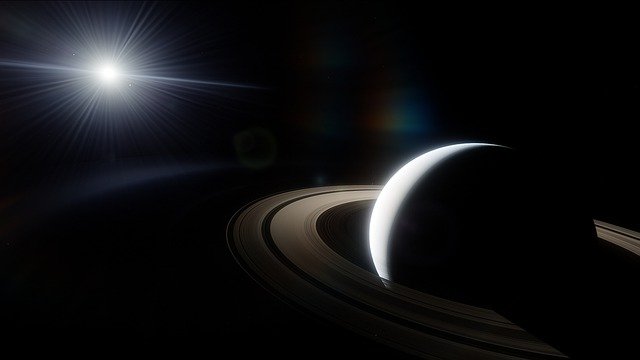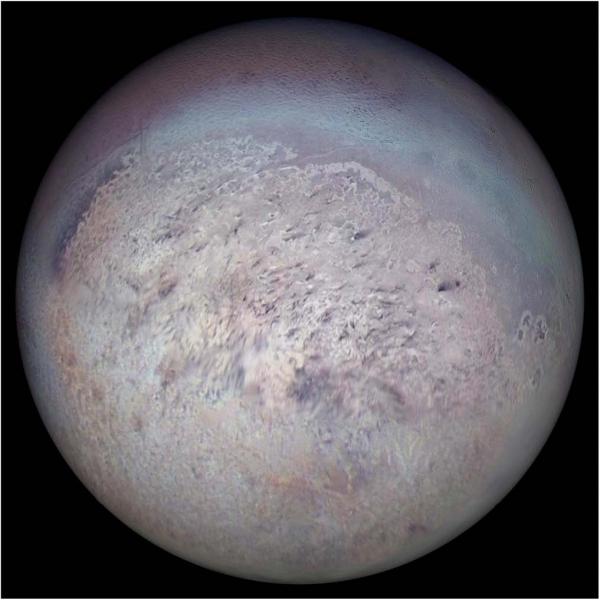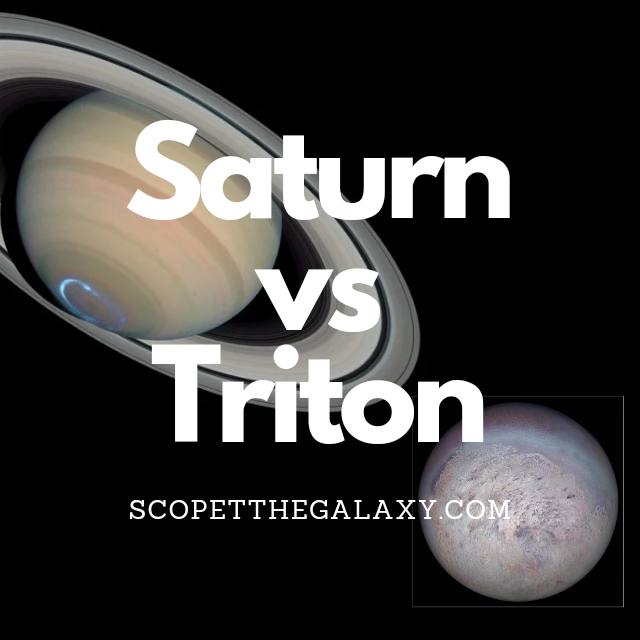*This post may contain affiliate links. This means we may make a commission if you purchase an item using one of our links*
The main differences between Saturn and Triton are that Saturn is a gas giant whilst Triton is a rock based natural satellite that orbits Neptune, Saturn is far bigger with a diameter of 116,460km whilst Triton has a diameter of 2,706km and Saturn has 7 distinguishable rings surrounding it whilst Triton has none.
There are numerous differences between these two entities so, continue reading for a more detailed look at each of these bodies along with their similarities and differences below
What Is The Planet Saturn?
Table of Contents

Saturn is the second largest planet in our solar system, that has a multitude of rings surrounding its gaseous exterior. It’s also the 6th farthest planet from the Sun.
As Saturn falls under the gas giant moniker, the planet is mostly made up of gases. However, Saturn’s composition is a little different from Jupiter’s where its atmosphere is mixture of hydrogen and ices containing elements of Ammonia.
It’s core on the other hand is comprised of a dense core of nickel and iron, which is then surrounded by rocks compressed so strongly that it can tends to reach scorching hot temperatures of 11,700+ degrees Celsius.
On the other hand, It’s gaseous atmosphere is far cooler. The exterior generally sits in the extreme sub zero range where Saturn’s temperatures is -138 degrees Celsius.
This is generally constant throughout the yellow ringed giants day to day. In fact it’s much colder than even the coldest place on Earth, which would be Eastern Antarctic Plateau, Antarctica that hits -94 degrees Celsius, which is more than 40 degrees Celsius warmer.
Being so large (116,460km), Saturn’s gravitational pull is obviously strong. That’s why over it’s 4.5 billion years of existence, beyond its rings this yellow gas giant has managed to accumulate 82 different moons along with other smaller interstellar debris that now orbit it.
In fact it’s largest moon Titan is literally bigger than one of the 8 planets orbiting the Sun, Mercury.
Saturn also orbits the Sun but, as the 6th farthest planet from it, it does mean a singular orbit will take it 29.4 Earth years to complete. In comparison to its axial orbit which only takes 10.7 hours, this is an extremely long time.
What Is The Moon Triton?

Triton is the largest moon of Neptune, whose most unusual feature is its retrograde orbit. Triton is the only major moon in our solar system which orbits in the opposite direction of its planet’s rotation.
First discovered on 10th October 1846 (just 17 days after the discovery of its planet, Neptune) by British astronomer William Lassell, “Triton” comes from a merman in Greek myth; a name which perhaps stems from the composition of this faraway moon.
The diameter of Triton is approximately 2,706km, making it a similar size to Earth’s moon. However, we know that its mass is far less than the first estimates suggested because data from Voyager showed that the surface is icy and highly reflective, a less dense composition than the dark surface of our moon.
This icy surface has resulted in ice based natural satellite displaying temperatures in the region of – 235 degrees Celsius.
This lower density stems predominantly from the water-ice interior encasing a denser rock core. Still, the mean density of 2.06 grams per cubic cm remains higher than that of any of Saturn’s or Uranus’ moons. In addition, Triton holds more than 99.5% of the mass of everything that orbits the planet Neptune and its total mass is greater than every smaller satellite in the solar system combined.
Scientists think that Triton may be an object from the Kuiper Belt that Neptune’s gravity captured millions of years ago. This is because it shares many similarities with the dwarf planet Pluto – the best-known world within the Kuiper Belt.
This frozen world is a land of geological oddities with craters and a collection of depressions and ridges known as cantaloupe terrain. The geysers found on this moon shoot plumes of nitrogen as high as 8km high, which creates a thin atmosphere of nitrogen.
In around 3.5 billion years, Triton’s orbit will travel too close to Neptune, and the planet’s gravitational pull will break the moon apart, creating a ring system.
Similarities Between Saturn And Triton
There are a few similarities that Saturn and Triton share, which in this case includes the following:
- Both are a spherical shape.
- Both have a hotter core.
- Both are part of the same solar system.
- Neither have tectonic plates.
- Both orbit another object.
Differences Between Saturn And Triton
In regards to the differences between the two, they include the below:
- Triton orbits Neptune whilst Saturn only orbits the Sun.
- Saturn has 7 rings surrounding it whilst Triton has 0.
- Saturn is a gas giant whilst Triton is a terrestrial based natural satellite.
- Saturn has 81 moons whilst Triton has 0.
- Saturn has a diameter of 116,460km whilst Triton’s diameter is 2,706km.
- Triton has a very thin exosphere composed mostly of nitrogen with small amounts of methane whilst Saturn is gas based, composed mostly of hydrogen and helium.
- A day on Triton takes 5.877 days whilst a Saturn takes 10.7 hours.
- It takes Triton 5.877 days to orbit Neptune and around the Sun in 165 years whilst Saturn orbits the Sun in 29.4 years.
- Saturn has an axial tilt of 26.73 degrees whilst Triton’s axial tilt is close to 0.
- Triton’s average temperature is around -235 degrees Celsius whilst Saturn has an average temperature of – 138 degrees Celsius.
- Saturn’s density is 0.687 g/cm³ whilst Triton’s density is 2.06 g/cm³.
- Saturn’s mass is 5.683 × 10^26 kg whilst Triton’s mass is 2.14 × 10^22 kg.
- Triton’s gravitational strength is 0.779 m/s² whilst Saturn is 10.44 m/s².
- Triton is the only moon in our solar system that orbits its planet in a retrograde orbit whilst Saturn orbits the Sun in the normal counter clockwise direction.
- Triton is tidally locked to Neptune whilst Saturn is not tidally locked to any entity.
- Saturn has a magnetosphere whilst Triton does not.
Summary
Saturn and Triton are worlds apart when it comes to their overall functionality and purpose within our solar system so it only makes sense that they are so distinct.
Therefore, all the differences between Saturn and Triton are easily recognizable when you pit the two against one another as can be seen within this article.

